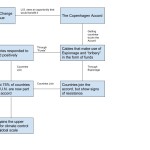The core ideas behind my system diagram is how the U.S. used espionage and funding’s (which I called bribery since that’s more or less what it is) to get countries to join the Copenhagen Accord, which was mostly written by the U.S. When countries heard that about 30 billion dollars in financial aid would be available to help assists in projects that would reduce their climate change impact, they jumped on board almost immediately. Some countries did not take the deal, but not nearly the same amount that joined the accord. One person from Brussels asked if the money would be in the form of cash, which I found to be sort of sketchy. The second part is making use of espionage. For example, the U.S. sent secret cables to Meles Zenawi, who heads the African Union for climate change. In the cable, the U.S. lays out an ultimatum stating that they “sign the accord or all discussion end now.” In my diagram, you can see that whatever course the U.S. took to get countries to back the Copenhagen Accord, more often than not, the countries joined. It would make sense to join if you are being offered money, but if you are being forced to join, you might show some resistance, like how the Netherlands found it hard that one of the conditions to receive any financial backing was to join the accord. As you can see from the diagram, the Copenhagen accord has been accepted by about 75% of the countries within the United Nations.
In my opinion, I think the cables should have been made public. My biggest problem with the Copenhagen accord is how the U.S. went about getting countries to join it. The cables probably should not have existed in the first place, as it can and has sparked some controversy. Also, the U.S. had the biggest hand in creating the accord. I’m sure that it is written in a way that can only make the U.S. reap the benefits to the maximum. I think that the U.S. should have went about this in a more diplomatic matter where each country helps to contribute to the accord. If the all the countries worked together to work towards a common goal or agreement on how to control the climate, it would probably be a much more powerful movement. What the Copenhagen accord really illustrates is that countries want money so that they can continue developing. There is a chance that they will not use the money properly, and that it may go towards something else. It also shows that the countries that were pushed into the accord don’t think that it is a good document to control the climate. However, they do not really have a choice, because its either there in and receive help, or they are left behind. Forcing someone into a cause without them understanding the cause almost never works. They are either there for something else, or because they have to be there. Unfortunately, this is often how politics works out.


Hello Tim, I am Tenaya. I found your diagram easy to understand and easy to follow. I too thought it was a little suspicious when Brussels asked if the fund would be in the form of cash. That one really made me think that, if cash was given, it would be almost impossible to follow how it gets dispersed and for what reasons. I liked how you mentioned forcing countries to join the cause when they dont understand what the cause is, I havent thought about that perspective. But you are right, if they dont understand the cause the odds are they wont work to help the cause. If you would like to read my blog here is the link, http://sites.psu.edu/geog30/2016/04/04/tenaya_mulvey-wikileaks-to-climate-change/
Hi Tim,
After reading your post, I found that our system diagrams were very similar. While you focused on the espionage of the United States, I also looked at how the United States was able to use its weight against other countries. The fact that 75% of countries have signed up for the accord is also surprising. But, one can argue that with having so many countries on board, that some progress will be made. I talked about, how even though the accord is flawed, that having a starting point and some countries on board is better than none.
You can read what I said on the topic below.
http://geog030.dutton.psu.edu/2016/04/05/module-9-the-copenhagen-accord/